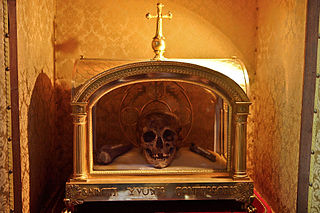
In religion, a relic is an object or article of religious significance from the past. It usually consists of the physical remains or personal effects of a saint or other person preserved for the purpose of veneration as a tangible memorial. Relics are an important aspect of some forms of Buddhism, Christianity, Islam, shamanism, and many other religions. Relic derives from the Latin reliquiae, meaning "remains", and a form of the Latin verb relinquere, to "leave behind, or abandon". A reliquary is a shrine that houses one or more religious relics.
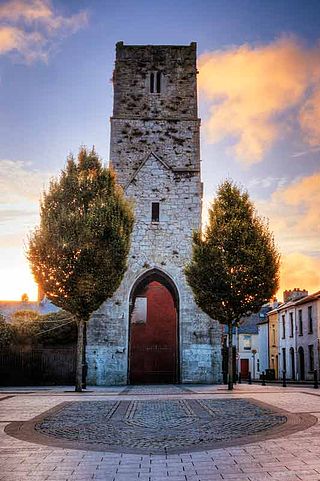
The Red Abbey in Cork, Ireland was a 14th-century Augustinian abbey which took its name from the reddish sandstone used in construction. Today all that remains of the structure is the central bell tower of the abbey church, which is one of the last remaining visible structures dating to the medieval walled town of Cork.

Saint Peter's tomb is a site under St. Peter's Basilica that includes several graves and a structure said by Vatican authorities to have been built to memorialize the location of Saint Peter's grave. St. Peter's tomb is alleged near the west end of a complex of mausoleums, the Vatican Necropolis, that date between about AD 130 and AD 300. The complex was partially torn down and filled with earth to provide a foundation for the building of the first St. Peter's Basilica during the reign of Constantine I in about AD 330. Though many bones have been found at the site of the 2nd-century shrine, as the result of two campaigns of archaeological excavation, Pope Pius XII stated in December 1950 that none could be confirmed to be Saint Peter's with absolute certainty. Following the discovery of bones that had been transferred from a second tomb under the monument, on June 26, 1968, Pope Paul VI said that the relics of Saint Peter had been identified in a manner considered convincing. Circumstantial evidence was provided to support the claim.

Ketevan the Martyr was a queen consort of Kakheti, a kingdom in eastern Georgia. She was regent of Kakheti during the minority of her son Teimuraz I of Kakheti from 1605 to 1614. She was killed at Shiraz, Iran, after prolonged tortures by the Safavid suzerains of Kakheti for refusing to give up the Christian faith and convert to Islam. She has been canonized as a saint by the Georgian Orthodox Church.

San Pietro in Ciel d'Oro is a Catholic basilica of the Augustinians in Pavia, Italy, in the Lombardy region. Its name refers to the mosaics of gold leaf behind glass tesserae that decorate the ceiling of the apse. The plain exterior is of brick, with sandstone quoins and window framing. The paving of the church floor is now lower than the modern street level of Piazza San Pietro in Ciel d'Oro, which lies before its façade.

The Order of Augustinian Recollects (OAR) is a mendicant Catholic religious order of friars and nuns. It is a reformist offshoot from the Augustinian hermit friars and follows the same Rule of St. Augustine. They have also been known as the "Discalced Augustinians".
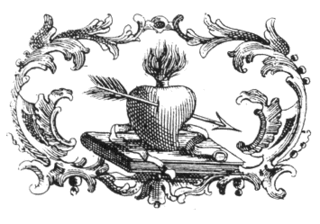
The Order of Saint Augustine, abbreviated OSA, is a mendicant religious order of the Catholic Church. It was founded in 1244 by bringing together several eremitical groups in the Tuscany region who were following the Rule of Saint Augustine, written by Saint Augustine of Hippo in the fifth century.

October 16 - Eastern Orthodox liturgical calendar - October 18

Georgia and India maintain diplomatic relations. The Embassy of India in Yerevan, Armenia is concurrently accredited to Georgia. Georgia maintains an embassy in New Delhi.
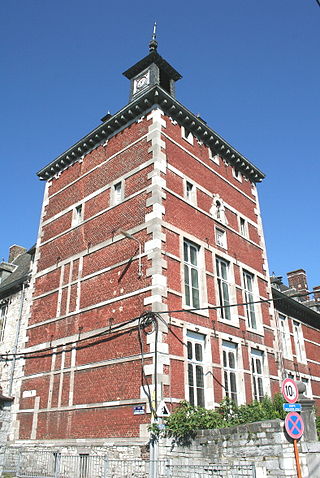
Flône Abbey is located on the left bank of the river Meuse at Flône (Amay), in the province of Liège, Wallonia, Belgium. It was founded in 1075.

Clare Abbey, also known as Clareabbey, is a ruined Augustinian monastery located near the Town of Ennis, along the banks of the Fergus River, and about a mile north of Clarecastle in County Clare, Ireland. The Abbey, founded in 1189, was the largest and most important of the Augustinian monasteries in County Clare.
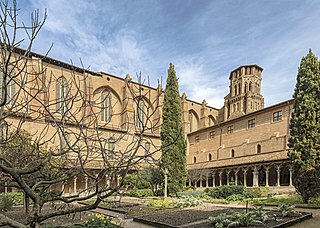
The Augustinian Convent of Toulouse was founded in 1286 for members of the Augustinian religious order. It was first established outside the city walls, near the Matabiau quarter, then, between 1310 and 1341 moved to the corner of rue du Musée and rue des Arts. In 1790 it ceased to be a convent and today its buildings house the Musée des Augustins.

Stephen is traditionally venerated as the protomartyr or first martyr of Christianity. According to the Acts of the Apostles, he was a deacon in the early church at Jerusalem who angered members of various synagogues by his teachings. Accused of blasphemy at his trial, he made a speech denouncing the Jewish authorities who were sitting in judgment on him and was then stoned to death. Saul of Tarsus, later known as Paul the Apostle, a Pharisee and Roman citizen who would later become an apostle, participated in Stephen's execution.

Santa Monica Parish Church, commonly known as Minalin Church, is a Baroque Roman Catholic church, located in poblacion area of San Nicolas in Minalin, Pampanga, Philippines. The church, built during the Spanish era, was declared a National Cultural Treasure by the National Commission for Culture and the Arts and the National Museum of the Philippines on August 27, 2011, one of 37 churches in the country bestowed that honor.

The Augustinian Friary of the Most Holy Trinity was an Augustinian Roman Catholic Priory, founded c. 1259, by the family of Talbot on the south bank of the river, in what is now Crow Street, Dublin. At the time the priory was built, it was just outside the city walls. The Friary most likely followed the design of the parent priory Clare Priory in the town of Clare, Suffolk (England). The Friary was suppressed in 1540 when it was described as a "church with belfry, a hall and dormitory". The friars continued to operate in secret within the city. and there are several mentions of them in the city archives until the late 1700s when they consecrated a new church.

San Pedro Apostol Parish Church, commonly known as Loboc Church and alternatively as the Diocesan Shrine of Our Lady of Guadalupe in Extremadura, is a Roman Catholic church in the municipality of Loboc, Bohol, Philippines, within the jurisdiction of the Diocese of Tagbilaran.

San Trifone in Posterula was an ancient titular church of Rome, now lost. It was located at the corner of Via dei Portoghesi and Via della Scrofa, in the Campo Marzio rione of the city.

Sant'Elena, also sometimes called Santa Lena, is a Gothic-style, Roman Catholic church at the extreme east end of the sestiere of Castello in the City of Venice, Italy.

Churches and Convents of Goa is the name given by UNESCO to a set of religious monuments located in Goa Velha, in the state of Goa, India, which were declared a World Heritage Site in 1986.

St Thomas of Canterbury Church is a Roman Catholic Parish church in Canterbury, Kent, England. It was built from 1874 to 1875 in the Gothic Revival style. It is situated on the corner of Burgate and Canterbury Lane, west of Lower Bridge Street, opposite the grounds of Canterbury Cathedral in the centre of the city. It is the only Roman Catholic church in Canterbury, built on the site of a medieval church ; the old St Mary Magdalen’s Tower was retained. The church contains relics of Thomas Becket.























